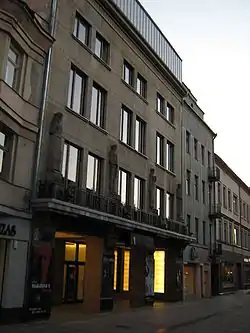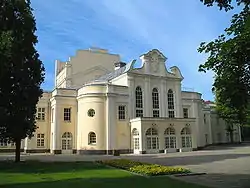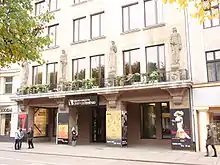Kaunas State Drama Theatre
The National Kaunas Drama Theatre is the biggest theatre in Kaunas, and one of the oldest functioning theatres in Lithuania. There are six different creative spaces for events in the Kaunas Drama Theatre.



History
Its beginnings date to the 1920s, when the Lithuanian Artists' Association established drama and opera playhouses. The first play performed by the Kaunas Drama Theatre was Hermann Sudermann's St. John's Day, directed by Juozas Vaičkus, premiering on December 19, 1920, in the former Russian City Theatre, in what is now the Kaunas State Musical Theatre. The company was the only professional theatre organization in Lithuania until 1931 when its branch opened in Šiauliai.
Dramas shared the house with opera, and in 1925 they were joined by ballet. At that time the theatre was renamed "State Theatre". Most of the actors initially came from Juozas Vaičkus' Flying Theatre, founded in 1918 in St. Petersburg, Russia.
After some reforms, Konstantinas Glinskis became its new manager. In 1926 he was forced out by the new manager, Antanas Sutkus, along with many other actors. Sutkus brought in actors from the defunct Vilkolakis and Tautos theatres.
In 1928 Sutkus was replaced by Jurgis Savickis, who in 1929 invited Andrius Oleka-Žilinskas from the Moscow Art Theatre. Oleka-Žilinskas sought to improve performances using the methods of Konstantin Stanislavsky and Vladimir Nemirovich-Danchenko, and as part of this goal, he invited the renowned Mikhail Chekhov to join the theatre. Together they trained young actors and established The Young Theatre; although their work was acclaimed by critics, the broader public showed little appreciation. Later Oleka-Žilinskas was forced to leave the theatre.
In 1940, when Lithuania was annexed by the Soviet Union, the theatre was forced to implement the socialist understanding of art and was forced to praise the new regime. During the Nazi occupation of Lithuania, demands for the praise of that regime were also made.
After the second Soviet occupation, socialist realism was enforced. In 1947 a group of Lithuanian students went to GITIS, Russia, and when they returned after graduating in 1952, a new era began at the theatre. In 1959 the organization was merged with the Kaunas Young Viewer's Theatre and moved to its present location at Laisvės alėja 71.
Notable actors
- Algirdas Masiulis
- Antanina Vainiūnaitė
- Dainius Svobonas
- Ingeborga Dapkūnaitė
- Juozas Budraitis
- Jūratė Onaitytė
- Konstantinas Glinskis
- Ona Jonaitytė
- Rūta Staliliūnaitė
- Viktoras Šinkariukas
- Vytautas Grigolis
Notable directors
- Andrius Oleka-Žilinskas
- Borisas Dauguvietis
- Eimuntas Nekrošius
- Gintaras Varnas
- Henrikas Vancevičius
- Jonas Jurašas
- Jonas Vaitkus
- Konstantinas Glinskis
- Stasys Motiejūnas
Notable scenographers
- Mstislav Dobuzhinsky
- Liudas Truikys
Notable plays
- Barbora Radvilaitė by Juozas Grušas
- Herkus Mantas by Juozas Grušas
- Baltaragis's Mill
- The Pilgrim of Dreams
- Ubu Roi by Alfred Jarry
- Thrush, the Green Bird